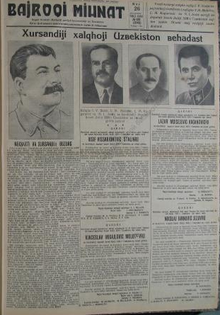Bajroqi Miⱨnat



Bajroqi Miⱨnat ('Banner of Labour'), initially known as Roshnoi ('Enlightement'), was a Bukharan Jewish language newspaper published from Samarkand 1925-1930 and Tashkent 1930-1938.
Roşnaji (1925-1930)[edit]
On November 16, 1925 the first issue of the lithographed publication Roşnaji ('Enlightenment') began publishing from Samarkand.[1] In the initial period Roşnaji had a very limited readership, with just 150-200 copies of each issue being printed by hand and distributed within the Jewish quarter of the city.[1][2] Haim Kalantrov headed the publication during its early phase.[2][3] Ilevumani Pinkasov was the first editor of the publication.[3] In 1926 the newspaper became an organ of the Jewish Section of the Communist Party.[2] Menashe Aminov became the editor of Roşnaji in 1927.[2][3][4] The Roşnaji readership gradually grew, reaching 700 copies per issue within a two-year span.[1] In 1928 Roşnaji began switching to Latin script.[2] With the somewhat more stable readership Roşnaji was able to afford to shift to mechanical printing, whereby the circulation increased to 1,000 copies.[1] Half a year later the print doubled to 2,000 copies.[1] In June 1929 Aharon Saidov, returning from studies at the Communist University of the Toilers of the East in Moscow, was named editor-in-chief of the newspaper.[3]
Bajroqi Miⱨnat (1930-1938)[edit]
In April 1930 the editorial office of the publication was moved to Tashkent and the newspaper was renamed Bajroqi Miⱨnat ('Banner of Labour').[1][3][5] The earlier name was deemed insufficiently 'Soviet' in character.[6] The editorial office and printing house were installed in the former synagogue in downtown Tashkent.[7] On April 8, 1931 the newspaper became an organ of the Central Bureau of the Bukharan Jewish Sections of the Central Committee of the Communist Party (bolsheviks) of Uzbekistan and the Organizational Commission on National Minorities of the Central Executive Committee of the Uzbek SSR.[7][3] Mordekhai Batchaev (Muhib) was the executive secretary of the publication.[3]
The newspaper continued to carry articles printed in Rashi (Hebrew) script until 1932, in spite of instructions from the Uzbek SSR government to switch fully to Latin script.[3][6] When it did switch to Latin script it initially avoided the use of Latin capital letters as per Jewish writing rules.[3]
The newspaper contained news stories translated from Russian language press, news from Bukharan Jewish community life (at one point Bajroqi Miⱨnat had some 380 local correspondents) and a literary supplement.[2] As of 1932-1933, circulation reached its peak at around 7,000 (which considering that the Bukharan Jewish community in its totality numbered about 20,000 individuals, implying that most Bukharan Jewish households subscribed to the newspaper).[6][2] By this point the newspaper was distributed among Bukharan Jewish communities across Central Asia.[1] In 1933 it became a daily newspaper.[8]
By 1935 circulation had dropped to about 5,000 copies per issue.[6] In its later phase the newspaper stopped using the term 'Bukharan Jews', changing to 'Central Asian Jews'.[3]
Yunatan Kurayev was named as the chief editor of Bajroqi Miⱨnat in 1938, shortly before the closure of the newspaper.[9] Publishing of Bajroqi Miⱨnat was discontinued in the midst of the Great Terror in June 1938.[2][3] Aminov, Pinkasov and Kalantrov suffered repression, and on June 6, 1938 Saidov was arrested.[3] Batchaev was arrested in early July 1938.[3]
References[edit]
- ^ a b c d e f g Lutz Rzehak. The Linguistic Challenge: Bukharan Jews and Soviet Language Policy
- ^ a b c d e f g h Yad Ben Zvi. עיתונות יהודית בשפה הטג’יקית־יהודית
- ^ a b c d e f g h i j k l m Rafael Nektal. Елена Коровай: иной взгляд. Бухарские евреи в русской культуре. Litres, 2022. p. 255
- ^ Меер Рахминович Беньяминов. Бухарские евреи. с.н., 1983. p. 14
- ^ Ato Akhrorov. Le Cinéma d'Asie centrale sovietique. Centre Georges Pompidou, 1991. p. 24
- ^ a b c d Zakharova, Larissa & Arel, Dominique & Cadiot, Juliette. (2009). Cacophonie d'empire. Le gouvernement des langues dans l'empire russe et en URSS.
- ^ a b Loy, T., & Levin, Z. (2022). From “Mercy” to “Banner of Labour”: the Bukharan Jewish press in late Tsarist and early Soviet Central Asia. Central Asian Survey, 41(1), pp. 22–40.
- ^ Shmuel Trigano. Le Monde sépharade - Histoire. Editions du Seuil.
- ^ Thomas Loy. Rise and Fall: Bukharan Jewish Literature of the 1920s and 1930s
External links[edit]
- Bajroqi Minhat archive at the National Library of Russia
